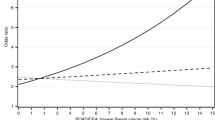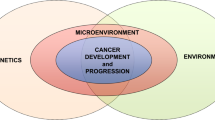Abstract
Inter-individual variability in carcinogen metabolism has been attributed in part to the polymorphic expression of several phase I and II detoxification enzymes. The role of these genetic polymorphisms in cancer susceptibility has been most extensively evaluated for isozymes of cytochrome P450 (CYP1A1, CYP2D6, and CYP2E1), N-acetyltransferase (NAT1 and NAT2), glutathione S-transferase (GSTM1, GSTT1, and GSTP1), microsomal epoxide hydrolase, and NAD(P)H:quinone oxidoreductase. Our understanding of the genetic basis of cancer risk has been enhanced most recently by establishment of genotype-phenotype correlations in humans and identification of numerous diverse factors, both genetic and environmental, that can modify risk.
Similar content being viewed by others
References and Recommended Reading
Nelson DR, Koymans L, Kamataki T, et al.: P450 superfamily: update on new sequences, gene mapping, accession numbers and nomenclature. Pharmacogenetics 1996, 6:1–42.
Whitlock JP: Induction of cytochrome P4501A1. Annual Rev Pharmacol Toxicol 1999, 39:103–125. This recent comprehensive review summarizes our current understanding of the regulation of CYP1A1. Implications for enhanced carcinogen activation and cancer susceptibility are discussed.
Cascorbi I, Brockmöller J, Mrozikiewicz PM, et al.: Homozygous rapid arylamine N-acetyltransferase (NAT2) genotype as a susceptibility factor for lung cancer. Cancer Res 1996, 56:3961–3966.
Iba MM, Scholl H, Fung J, et al.: Induction of pulmonary CYP1A1 by nicotine. Xenobiotica 1998, 28:827–843. Extensive animal data are presented to support the classification of nicotine as a potent inducer of CYP1A1. In addition to further elucidating the mechanism by which cigarette smoke induces CYP1A1, the results from this study imply that nicotine replacement products could increase cancer risk.
Benet LZ, Kroetz DL, Sheiner LB: Pharmacokinetics. In Goodman and Gilman’s Pharmacological Basis of Therapeutics, edn 9. Edited by Hardman LG, Goodman Gilman A, Limbird LE. New York: McGraw-Hill; 1996:3–27.
Wolf CR, Smith G: Cytochrome P450 CYP2D6. In Metabolic Polymorphisms and Susceptibility to Cancer. Edited by Vineis P, Malats N, Lang M, d’Errico A, et al. Lyon, France: International Agency for Research on Cancer; 1999:209–229. This new release from IARC is an excellent, comprehensive overview of all of the metabolic polymorphisms that have been identified to date. The potential contribution of each to cancer susceptibility is discussed in detail.
Le Marchand L, Sivaraman L, Pierce L, et al.: Associations of CYP1A1, GSTM1, and CYP2E1 polymorphisms with lung cancer suggest cell type specificities to tobacco carcinogens. Cancer Res 1998, 58:4858–4863.
Hsieh FI, Pu YS, Chern HD, et al.: Genetic polymorphisms of N-acetyltransferase 1 and 2 and risk of cigarette smokingrelated bladder cancer. Br J Cancer 1999, 81:537–541.
Gertig DM, Hankinson SE, Hough H, et al.: N-acetyl transferase 2 genotypes, meat intake and breast cancer risk. Int J Cancer 1999, 80:13–17.
Chen J, Stampfer MJ, Hough HL, et al.: A prospective study of N-acetyltransferase genotype, red meat intake, and risk of colorectal cancer. Cancer Res 1998, 58:3307–3311.
Katoh T, Kaneko S, Boissy R, et al.: A pilot study testing the association between N-acetyltransferases 1 and 2 and risk of oral squamous cell carcinoma in Japanese people. Carcinogenesis 1998, 19:1803–1807.
Moisio ML, Sistonen P, Mecklin JP, et al.: Genetic polymorphisms in carcinogen metabolism and their association to hereditary nonpolyposis colon cancer. Gastroenterology 1998, 115:1387–1394. This unique study evaluates genetic polymorphisms in individuals with a heritable cancer syndrome. The results suggest that metabolic polymorphisms can modulate the cancer phenotype among individuals with a mutation in the mismatch repair gene MLH1.
Heinimann K, Scott RJ, Chappuis P, et al.: N-acetyltransferase 2 influences cancer prevalence in hMLH1/hMSH2 mutation carriers. Cancer Res 1999, 59:3038–3040.
Houlston RS: Glutathione S-transferase M1 status and lung cancer risk: a meta-analysis. Cancer Epidemiol Biomarkers Prev 1999, 8:675–682.
Helzlsouer KJ, Selmin O, Huang HY, et al.: Association between glutathione S-transferase M1, P1, and T1 genetic polymorphisms and development of breast cancer. J Natl Cancer Inst 1998, 90:512–518.
Gertig DM, Stampfer M, Haiman C, et al.: Glutathione S-transferase GSTM1 and GSTT1 polymorphisms and colorectal cancer risk: a prospective study. Cancer Epidemiol Biomarkers Prev 1998, 7:1001–1005.
Hengstler JG, Kett A, Arand M, et al.: Glutathione S-transferase T1 and M1 gene defects in ovarian cancer. Cancer Lett 1998, 130:43–48.
Ali-Osman F, Akande N, Mao J: Molecular cloning, characterization and expression of novel functionally different human glutathione S-transferase-P-1 gene variant. Proceedings of the International ISSX Workshop on Glutathione S-Transferase 1995, 7:38.
Zimniak P, Nanduri B, Pikula S, et al.: Naturally-occurring human glutathione S-transferase GSTP1-1 isoforms with isoleucine and valine in position 104 differ in enzymatic properties. Eur J Biochem 1994, 244:893–899.
Jourenkova-Mironova N, Voho A, Bouchardy C, et al.: Glutathione S-transferase GSTM1, GSTM3, GSTP1 and GSTT1 genotypes and the risk of smoking-related oral and pharyngeal cancers. Int J Cancer 1999, 81:44–48.
Jourenkova-Mironova N, Voho A, Bouchardy C, et al.: Glutathione S-transferase GSTM3 and GSTP1 genotypes and larynx cancer risk. Cancer Epidemiol Biomarkers Prev 1999, 8:185–188.
Katoh T, Kaneko S, Takasawa S, et al.: Human glutathione S-transferase P1 polymorphism and susceptibility to smoking related epithelial cancer; oral, lung, gastric, colorectal and urothelial. Pharmacogenetics 1999, 9:165–169.
Hassett C, Aicher L, Sidhu JS, et al.: Human microsomal epoxide hydrolase: genetic polymorphism and functional expression in vitro of amino acid variants. Hum Mol Genet 1994, 3:421–428.
Harrison DJ, Hubbard AL, MacMillan J, et al.: Microsomal epoxide hydrolase gene polymorphism and susceptibility to colon cancer. Br J Cancer 1999, 79:168–171.
Benhamou S, Reinikainen M, Bouchardy C, et al.: Association between lung cancer and microsomal epoxide hydrolase genotypes. Cancer Res 1998, 58:5291–5293.
Hengstler JG, Arand M, Herrero ME, et al.: Polymorphisms of N-acetyltransferases, glutathione S-transferases, microsomal epoxide hydrolase and sulfotransferases: influence on cancer susceptibility. Recent Results Cancer Res 1998, 154:47–85.
Traver RD, Siegel D, Beall HD, et al.: Characterization of a polymorphism in NAD(P)H:quinone oxidoreductase (DT-diaphorase). Br J Cancer 1997, 75:69–75.
Steiner M, Hillenbrand M, Borkowsi M, et al.: 609 C to T polymorphism in NAD(P)H:quinone oxidoreductase gene in patients with prostatic adenocarcinoma or benign prostatic hyperplasia. Cancer Lett 1999, 135:67–71.
Butkiewicz D, Cole KJ, Phillips DH, et al.: GSTM1, GSTP1, CYP1A1 and CYP2D6 polymorphisms in lung cancer patients from an environmentally polluted region of Poland: correlation with lung DNA adduct levels. Eur J Cancer Prev 1999, 8:315–323.
Ryberg D, Skaug V, Hewer A, et al.: Genotypes of glutathione transferase M1 and P1 and their significance for lung DNA adduct levels and cancer risk. Carcinogenesis 1997, 19:1285–1289.
Pastorelli R, Guanci M, Cerri A, et al.: Impact of inherited polymorphisms in glutathione S-transferase M1, microsomal epoxide hydrolase, cytochrome P450 enzymes on DNA, and blood protein adducts of benzo(a)pyrene-diolepoxide. Cancer Epidemiol Biomarkers Prev 1998, 7:703–709.
Wu M-T, Huang S-L, Ho C-K, et al.: Cytochrome P450 1A1 MspI polymorphism and urinary 1-hydroxypyrene concentrations in coke-oven workers. Cancer Epidemiol Biomarkers Prev 1998, 7:823–829.
Przygodzki RM, Bennett WP, Guinee DGJr, et al.: p53 mutation spectrum in relation to GSTM1, CYP1A1 and CYP2E1 in surgically treated patients with non-small cell lung cancer. Pharmacogenetics 1998, 8:503–511.
Kawajiri K, Eguchi H, Nakachi K, et al.: Association of CYP1A1 germ line polymorphisms with mutations of the p53 gene in lung cancer. Cancer Res 1996, 56:72–76.
Dresler CM, Fratelli C, Babb J, et al.: Women with a CYP1A1 polymorphism are at significantly increased risk of developing lung cancer. Proc Am Assoc Cancer Res 1999, 40:567.
Mollerup S, Ryberg D, Hewer A, et al.: Sex differences in lung CYP1A1 expression and DNA adduct levels among lung cancer patients. Cancer Res 1999, 59:3317–3320. This study represents the first report of the functional significance of gender differences in CYP1A1 expression in humans. Significantly higher levels of DNA adducts were present in normal lung tissue from female smokers (vs males) and correlated directly with increased CYP1A1 activity.
Ishibe N, Wiencke JK, Zuo ZF, et al.: Susceptibility to lung cancer in light smokers associated with CYP1A1 polymorphisms in Mexican- and African-Americans. Cancer Epidemiol Biomarkers Prev 1997, 6:1075–1080.
Park JY, Muscat JE, Ren Q, et al.: CYP1A1 and GSTM1 polymorphisms and oral cancer risk. Cancer Epidemiol Biomarkers Prev 1997, 6:791–797.
Saarikoski ST, Voho A, Reinikainen M, et al.: Combined effect of polymorphic GST genes on individual susceptibility to lung cancer. Int J Cancer 1998, 77:516–521.
Ishibe N, Hankinson SE, Colditz GA, et al.: Cigarette smoking, cytochrome P450 1A1 polymorphisms, and breast cancer risk in the Nurses’ Health Study. Cancer Res 1998, 58:667–671.
García-Closas M, Kelsey KT, Wiencke JK, et al.: A case-control study of cytochrome P450 1A1, glutathione S-transferase M1, cigarette smoking and lung cancer susceptibility (Massachusetts, United States). Cancer Causes Control 1997, 8:544–553.
Garte S: The role of ethnicity in cancer susceptibility gene polymorphisms: the example of CYP1A1. Carcinogenesis 1998, 19:1329–1332.
Taioli E: International collaborative study on genetic susceptibility to environmental carcinogens. Cancer Epidemiol Biomarkers Prev 1999, 8:727–728.
Author information
Authors and Affiliations
Rights and permissions
About this article
Cite this article
Clapper, M.L. Genetic polymorphism and cancer risk. Curr Oncol Rep 2, 251–256 (2000). https://doi.org/10.1007/s11912-000-0075-z
Issue Date:
DOI: https://doi.org/10.1007/s11912-000-0075-z




